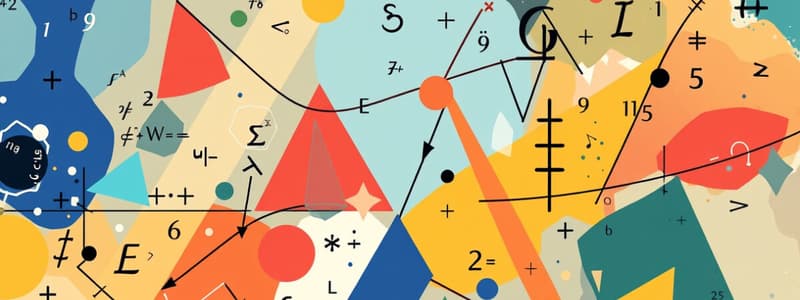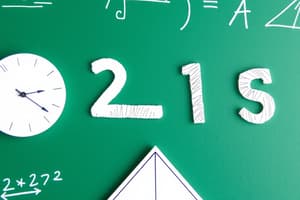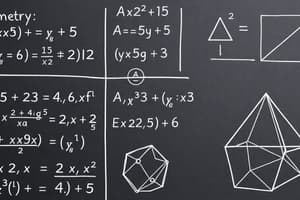Podcast
Questions and Answers
The basic operations in arithmetic include addition, subtraction, multiplication, and ______.
The basic operations in arithmetic include addition, subtraction, multiplication, and ______.
division
In algebra, expressions, equations, and ______ are key concepts.
In algebra, expressions, equations, and ______ are key concepts.
inequalities
The Pythagorean ______ is a fundamental theorem in geometry.
The Pythagorean ______ is a fundamental theorem in geometry.
theorem
In trigonometry, the ratios used are sine, cosine, and ______.
In trigonometry, the ratios used are sine, cosine, and ______.
Calculus involves the study of limits, derivatives, and ______.
Calculus involves the study of limits, derivatives, and ______.
Measures of central tendency include mean, median, and ______.
Measures of central tendency include mean, median, and ______.
Set theory and logic are important topics in ______ mathematics.
Set theory and logic are important topics in ______ mathematics.
Mathematical ______ involves logical reasoning to justify statements.
Mathematical ______ involves logical reasoning to justify statements.
Flashcards are hidden until you start studying
Study Notes
Key Areas of Mathematics
-
Arithmetic
- Basic operations: addition, subtraction, multiplication, division.
- Understanding of whole numbers, fractions, decimals, and percentages.
- Order of operations (PEMDAS/BODMAS).
-
Algebra
- Variables and constants.
- Expressions, equations, and inequalities.
- Functions and their properties.
- Solving linear and quadratic equations.
- Polynomials and factoring.
-
Geometry
- Basic shapes: triangles, quadrilaterals, circles.
- Properties of angles, lines, and surfaces.
- Area, perimeter, and volume calculations.
- Theorems: Pythagorean theorem, properties of parallel lines.
-
Trigonometry
- Trigonometric ratios: sine, cosine, tangent.
- Unit circle and angle measurements (degrees and radians).
- Applications in right triangles and periodic functions.
-
Calculus
- Limits and continuity.
- Derivatives and their applications (slope of a curve, rate of change).
- Integrals and area under curves.
- Fundamental theorem of calculus.
-
Statistics
- Data collection methods: surveys, experiments.
- Measures of central tendency: mean, median, mode.
- Measures of dispersion: range, variance, standard deviation.
- Probability concepts and distributions (normal, binomial).
-
Discrete Mathematics
- Set theory and logic.
- Combinatorics and counting principles.
- Graph theory and algorithms.
- Mathematical reasoning and proof techniques.
-
Mathematical Thinking
- Problem-solving strategies.
- Patterns and sequences.
- Mathematical modeling and applications in real-world contexts.
Important Concepts
- Mathematical Proofs: Logical reasoning to justify statements.
- Functions: Relationships between sets, defined by input-output pairs.
- Theorems: Established results that can be proven based on previously accepted statements.
Tools and Techniques
- Graphing: Visual representation of functions and data.
- Calculators: Tools for computation and graphing.
- Software: Applications for solving complex mathematical problems (e.g., MATLAB, Mathematica).
Study Tips
- Practice regularly to strengthen core concepts.
- Work on a variety of problems to understand different applications.
- Study in groups to enhance understanding through discussion.
- Utilize online resources and tutorials for additional guidance.
Key Areas of Mathematics
-
Arithmetic: Involves fundamental operations such as addition, subtraction, multiplication, and division. Understanding of whole numbers, fractions, decimals, and percentages is essential. The order of operations is crucial, often remembered by PEMDAS/BODMAS.
-
Algebra: Focuses on variables, constants, and the manipulation of expressions, equations, and inequalities. Key skills include solving linear and quadratic equations, as well as working with polynomials and their factoring.
-
Geometry: Studies basic shapes like triangles, quadrilaterals, and circles, along with properties of angles, lines, and surfaces. Key calculations involve area, perimeter, and volume. Important theorems include the Pythagorean theorem and properties of parallel lines.
-
Trigonometry: Centers on trigonometric ratios such as sine, cosine, and tangent. Understanding the unit circle and angle measurements in both degrees and radians is essential. Applications include solving problems related to right triangles and understanding periodic functions.
-
Calculus: Encompasses limits and concepts of continuity, derivatives (rate of change), and integrals (area under curves). The fundamental theorem of calculus connects derivatives and integrals, providing the backbone for many applications.
-
Statistics: Involves data collection techniques such as surveys and experiments. Central tendency measures (mean, median, mode) are critical, as well as measures of dispersion (range, variance, standard deviation). Probability concepts and various distributions, including normal and binomial, are fundamental.
-
Discrete Mathematics: Covers set theory and logic, combinatorics (counting principles), graph theory, and algorithms. Emphasizes mathematical reasoning and proof techniques.
-
Mathematical Thinking: Encourages problem-solving strategies and emphasizes recognizing patterns and sequences. Mathematical modeling helps apply concepts to real-world situations.
Important Concepts
-
Mathematical Proofs: Involves logical reasoning that systematically justifies mathematical statements and conclusions.
-
Functions: Describe relationships between sets, defined by specified input-output pairs, critical for understanding algebra and calculus.
-
Theorems: Established mathematical results that are proven based on previously accepted principles, reinforcing the structure of mathematical knowledge.
Tools and Techniques
-
Graphing: Essential for visual representation of mathematical functions and data relationships, aiding in understanding complex concepts.
-
Calculators: Serve as computational aids for arithmetic and graphing, streamlining problem-solving processes.
-
Software: Advanced applications like MATLAB and Mathematica assist in solving complicated mathematical problems, enhancing computational efficiency and visualization.
Study Tips
-
Consistent practice is key to reinforcing core mathematical concepts and enhancing skillsets.
-
Engage with a variety of problems to grasp different applications and deepen understanding.
-
Studying in groups can foster discussion and collaborative learning, enhancing comprehension of complex topics.
-
Utilize online resources and tutorials for supplementary guidance, allowing for diverse learning methods.
Studying That Suits You
Use AI to generate personalized quizzes and flashcards to suit your learning preferences.




